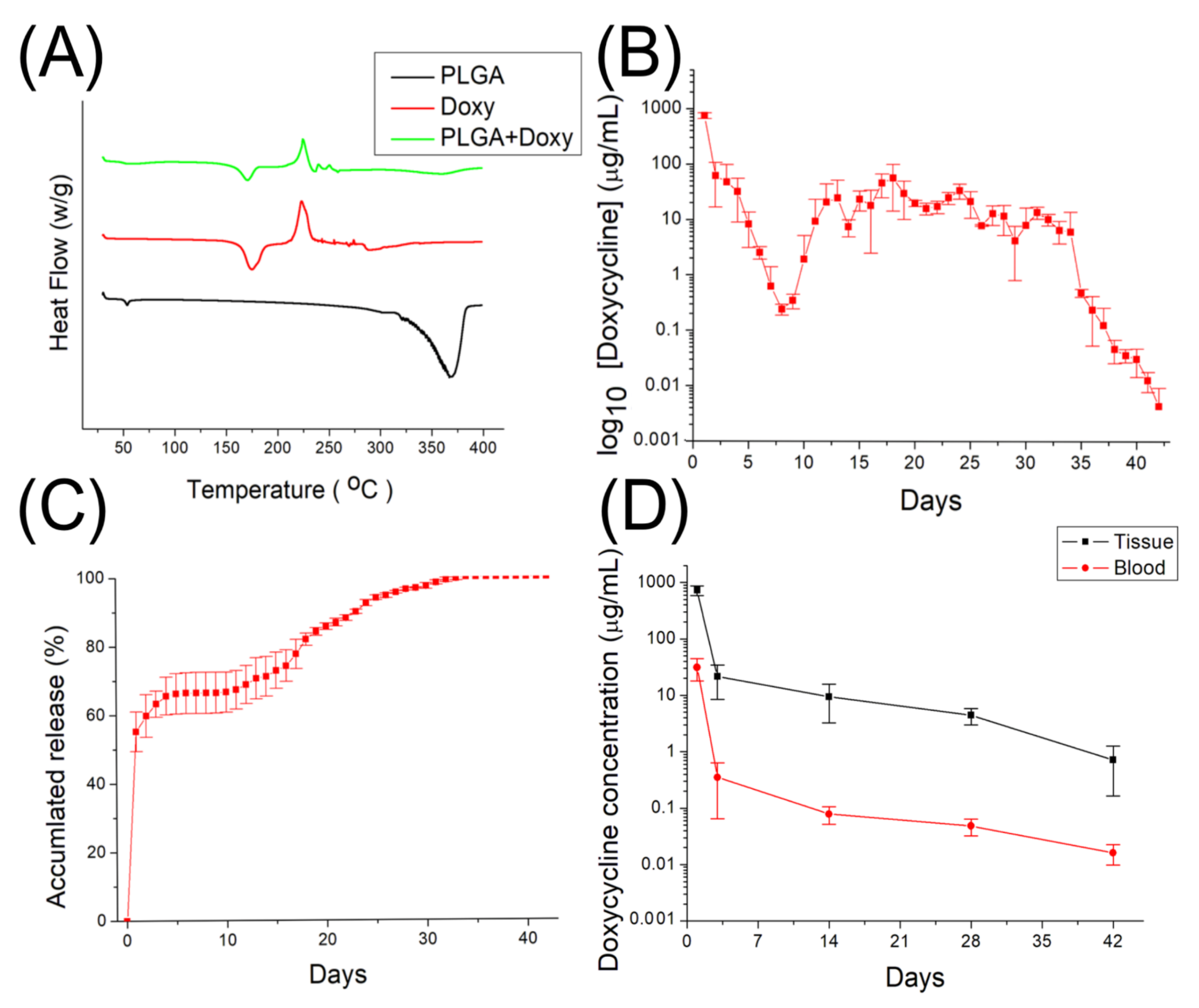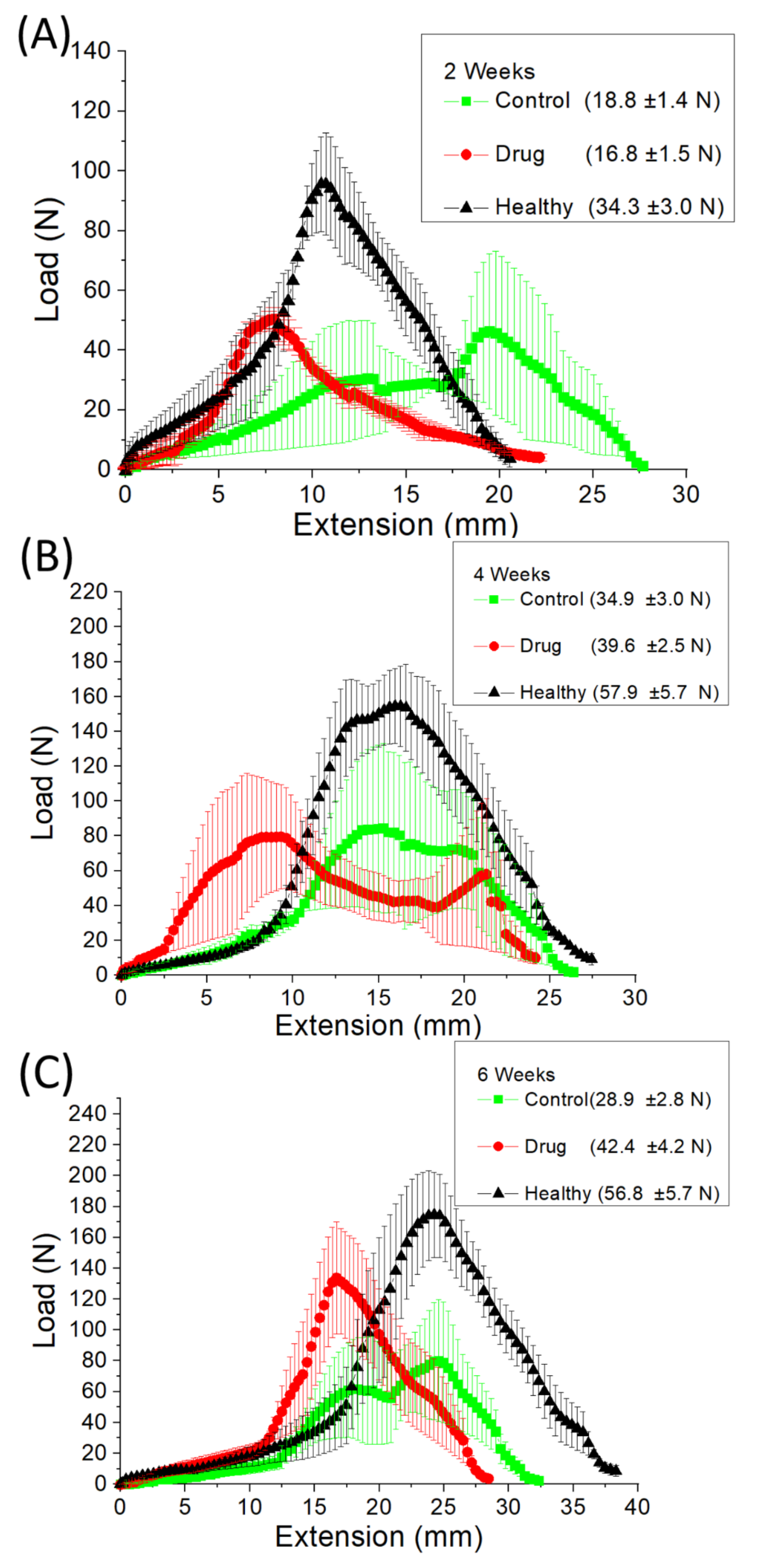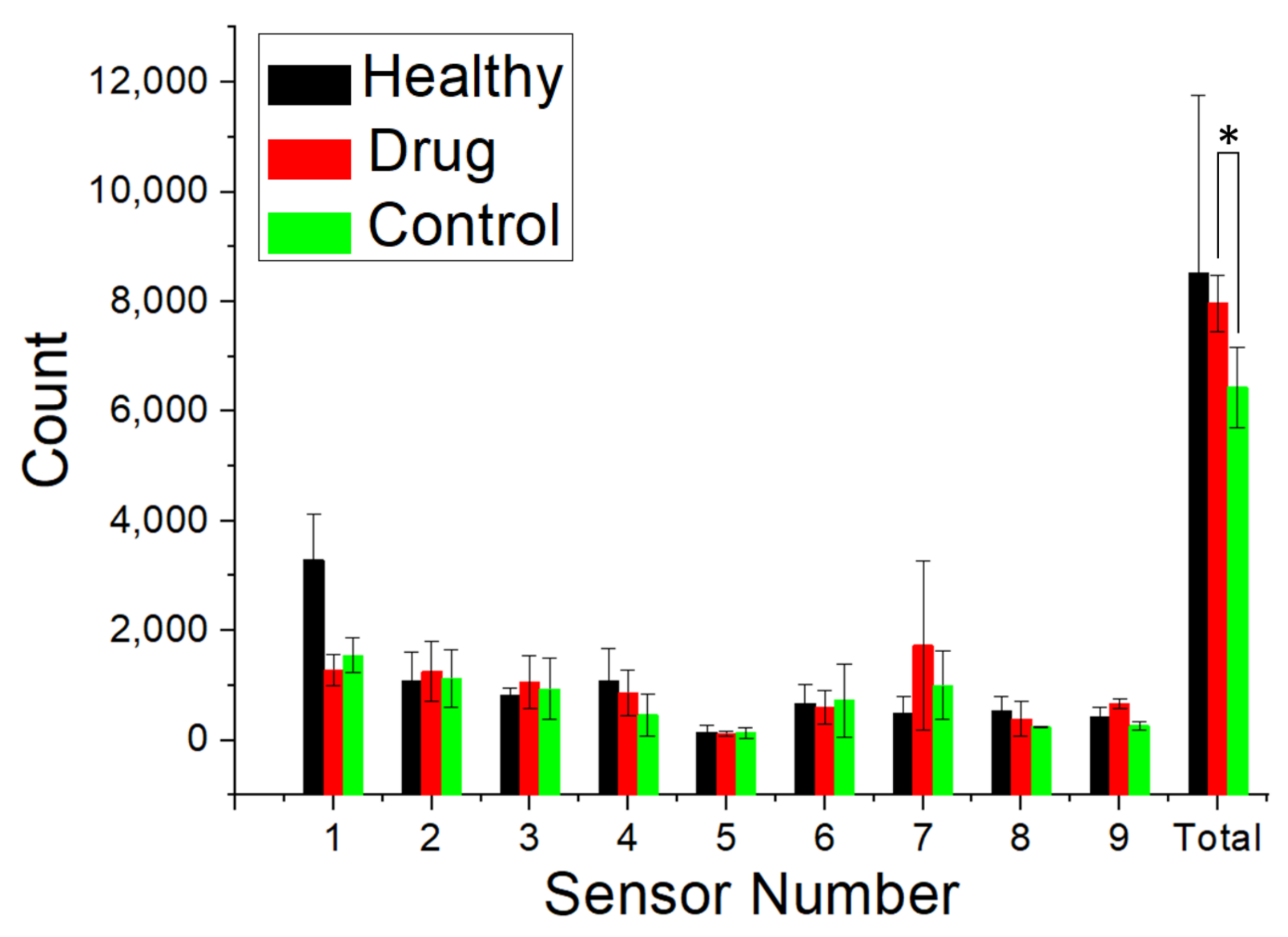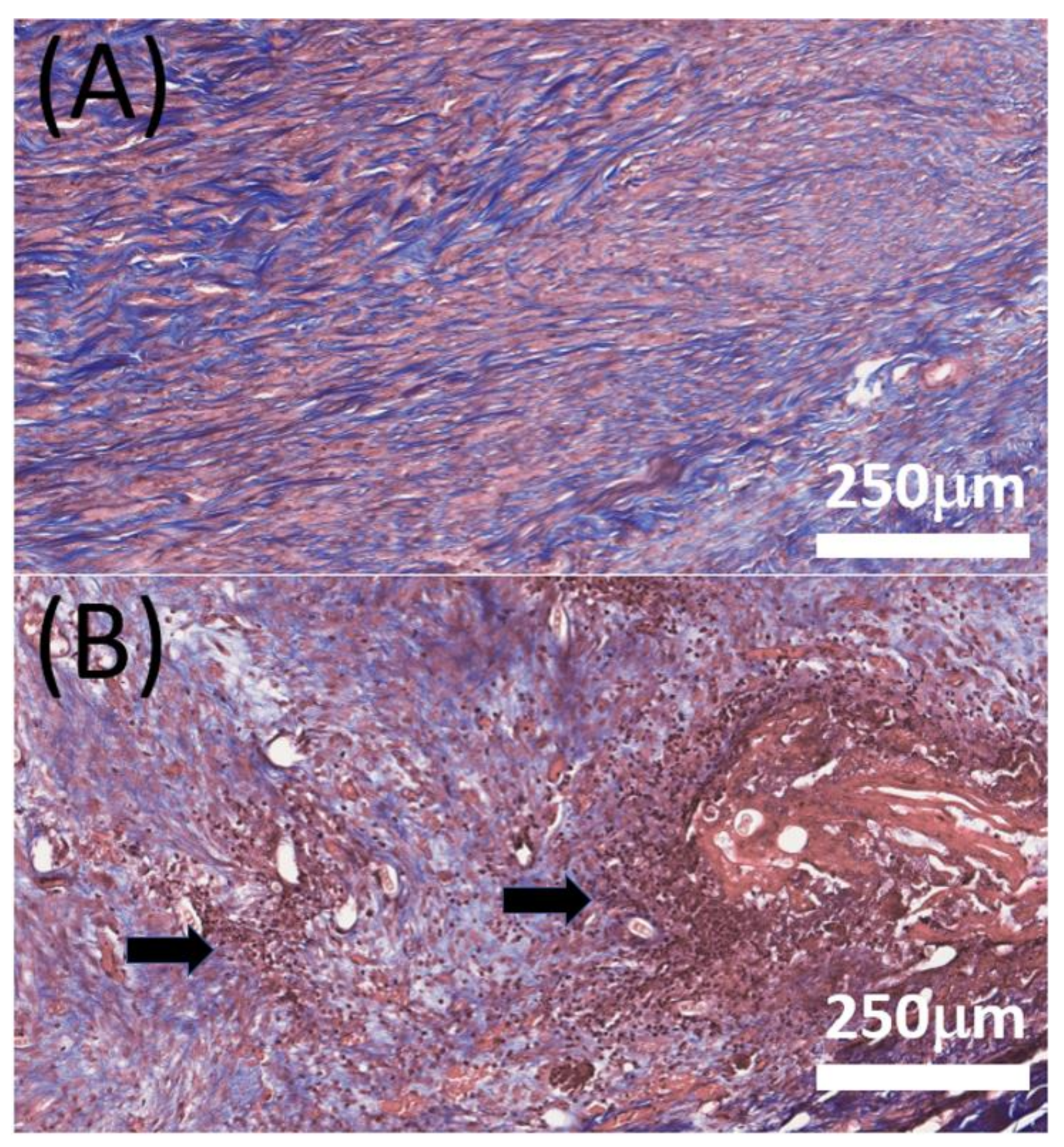Electrospun, Resorbable, Drug-Eluting, Nanofibrous Membranes Promote Healing of Allograft Tendons
Abstract
:1. Introduction
2. Materials and Methods
2.1. Materials
2.2. Fabrication of Doxycycline-Loaded Nanofibers
2.3. In Vitro Release Patterns of Pharmaceuticals
2.4. Animal Experiments
2.5. In Vivo Drug Release
2.6. Post-Operation Activity Testing
2.7. Biomechanical Strength Testing
2.8. Histological Analysis
2.9. Statistical Analysis
3. Results
3.1. Assessment of Spun Doxycycline-Loaded Nanofibers
3.2. Doxycycline Release
3.3. Biomechanical Strength Study
3.4. Animal Activity
3.5. Histological Study
4. Discussion
5. Conclusions
Author Contributions
Funding
Institutional Review Board Statement
Data Availability Statement
Conflicts of Interest
References
- Huttunen, T.T.; Kannus, P.; Rolf, C.; Fellander-Tsai, L.; Mattila, V.M. Acute Achilles tendon ruptures: Incidence of injury and surgery in Sweden between 2001 and 2012. Am. J. Sports Med. 2014, 42, 2419–2423. [Google Scholar] [CrossRef] [PubMed]
- Cottom, J.M.; Sisovsky, C.A. Neglected Achilles tendon ruptures. Clin. Podiatr. Med. Surg. 2021, 38, 261–277. [Google Scholar] [CrossRef] [PubMed]
- Bussewitz, B.W. Repair of neglected Achilles rupture. Clin. Podiatr. Med. Surg. 2017, 34, 263–274. [Google Scholar] [CrossRef] [PubMed]
- Maffulli, N.; Via, A.G.; Oliva, F. Chronic Achilles tendon rupture. Open Orthop. J. 2017, 11, 660–669. [Google Scholar] [CrossRef] [PubMed] [Green Version]
- Arshad, Z.; Lau, E.J.S.; Leow, S.H.; Bhatia, M. Management of chronic Achilles ruptures: A scoping review. Int. Orthop. 2021, 45, 2543–2559. [Google Scholar] [CrossRef]
- Schweitzer, K.M., Jr.; Dekker, T.J.; Adams, S.B. Chronic Achilles ruptures: Reconstructive options. J. Am. Acad. Orthop. Surg. 2018, 26, 753–763. [Google Scholar] [CrossRef]
- Jiang, X.J.; Shen, J.J.; Huang, J.F.; Tong, P.J. Reconstruction of Myerson type III chronic Achilles tendon ruptures using semitendinosus tendon and gracilis tendon autograft. J. Orthop. Surg. 2019, 27, 2309499019832717. [Google Scholar] [CrossRef] [Green Version]
- Wilding, C.S.R.; Cruz, C.C.A.; Mannino, L.B.J.; Deal, C.J.B.; Wake, C.J.; Bottoni, C.R. Bone-tendon-autograft anterior cruciate ligament reconstruction: A new anterior cruciate ligament graft option. Arthrosc. Tech. 2020, 9, e1525–e1530. [Google Scholar] [CrossRef]
- Floyd, E.R.; Carlson, G.B.; la Prade, R.F. Patellar tendon revision reconstruction with hamstring tendon autografts. Arthrosc. Tech. 2021, 10, e873–e876. [Google Scholar] [CrossRef]
- Sheean, A.J.; Musahl, V.; Slone, H.S.; Xerogeanes, J.W.; Milinkovic, D.; Fink, C.; Hoser, C.; International Quadriceps Tendon Interest, Group. Quadriceps tendon autograft for arthroscopic knee ligament reconstruction: Use it now, use it often. Br. J. Sports Med. 2018, 52, 698–701. [Google Scholar] [CrossRef]
- Dederer, K.M.; Tennant, J.N. Anatomical and functional considerations in Achilles tendon lesions. Foot Ankle Clin. 2019, 24, 371–385. [Google Scholar] [CrossRef] [PubMed]
- Sharma, P.; Maffulli, N. Tendon injury and tendinopathy: Healing and repair. J. Bone Jt. Surgery. Am. Vol. 2005, 87, 187–202. [Google Scholar] [CrossRef] [Green Version]
- Del Buono, A.; Oliva, F.; Longo, U.G.; Rodeo, S.A.; Orchard, J.; Denaro, V.; Maffulli, N. Metalloproteases and rotator cuff disease. J. Shoulder Elb. Surg. 2012, 21, 200–208. [Google Scholar] [CrossRef] [PubMed]
- Gotoh, M.; Mitsui, Y.; Shibata, H.; Yamada, T.; Shirachi, I.; Nakama, K.; Okawa, T.; Higuchi, F.; Nagata, K. Increased matrix metalloprotease-3 gene expression in ruptured rotator cuff tendons is associated with postoperative tendon retear. Knee Surg. Sports Traumatol. Arthrosc. Off. J. ESSKA 2013, 21, 1807–1812. [Google Scholar] [CrossRef] [PubMed]
- Thomopoulos, S.; Parks, W.C.; Rifkin, D.B.; Derwin, K.A. Mechanisms of tendon injury and repair. J. Orthop. Res. Off. Publ. Orthop. Res. Soc. 2015, 33, 832–839. [Google Scholar] [CrossRef] [Green Version]
- Gong, F.; Cui, L.; Zhang, X.; Zhan, X.; Gong, X.; Wen, Y. Piperine ameliorates collagenase-induced Achilles tendon injury in the rat. Connect. Tissue Res. 2018, 59, 21–29. [Google Scholar] [CrossRef]
- Fernandes de Jesus, J.; Spadacci-Morena, D.D.; Rabelo, N.; Pinfildi, C.E.; Fukuda, T.Y.; Plapler, H. Photobiomodulation of matrix metalloproteinases in rat calcaneal tendons. Photobiomodulation Photomed. Laser Surg. 2019, 37, 421–427. [Google Scholar] [CrossRef]
- Lo, I.K.; Marchuk, L.L.; Hollinshead, R.; Hart, D.A.; Frank, C.B. Matrix metalloproteinase and tissue inhibitor of matrix metalloproteinase mRNA levels are specifically altered in torn rotator cuff tendons. Am. J. Sports Med. 2004, 32, 1223–1229. [Google Scholar] [CrossRef]
- Jones, G.C.; Corps, A.N.; Pennington, C.J.; Clark, I.M.; Edwards, D.R.; Bradley, M.M.; Hazleman, B.L.; Riley, G.P. Expression profiling of metalloproteinases and tissue inhibitors of metalloproteinases in normal and degenerate human Achilles tendon. Arthritis Rheum. 2006, 54, 832–842. [Google Scholar] [CrossRef] [Green Version]
- Pasternak, B.; Schepull, T.; Eliasson, P.; Aspenberg, P. Elevation of systemic matrix metalloproteinases 2 and 7 and tissue inhibitor of metalloproteinase 2 in patients with a history of Achilles tendon rupture: Pilot study. Br. J. Sports Med. 2010, 44, 669–672. [Google Scholar] [CrossRef]
- Dong, M.; Zhong, L.; Chen, W.Q.; Ji, X.P.; Zhang, M.; Zhao, Y.X.; Li, L.; Yao, G.H.; Zhang, P.F.; Zhang, C.; et al. Doxycycline stabilizes vulnerable plaque via inhibiting matrix metalloproteinases and attenuating inflammation in rabbits. PLoS ONE 2012, 7, e39695. [Google Scholar] [CrossRef] [PubMed]
- Griffin, M.O.; Ceballos, G.; Villarreal, F.J. Tetracycline compounds with non-antimicrobial organ protective properties: Possible mechanisms of action. Pharmacol. Res. 2011, 63, 102–107. [Google Scholar] [CrossRef] [PubMed]
- Kim, Y.; Kim, J.; Lee, H.; Shin, W.R.; Lee, S.; Lee, J.; Park, J.I.; Jhun, B.H.; Kim, Y.H.; Yi, S.J.; et al. Tetracycline analogs inhibit osteoclast differentiation by suppressing MMP-9-mediated histone H3 cleavage. Int. J. Mol. Sci. 2019, 20, 4038. [Google Scholar] [CrossRef] [PubMed] [Green Version]
- Arnoczky, S.P.; Lavagnino, M.; Egerbacher, M.; Caballero, O.; Gardner, K. Matrix metalloproteinase inhibitors prevent a decrease in the mechanical properties of stress-deprived tendons: An in vitro experimental study. Am. J. Sports Med. 2007, 35, 763–769. [Google Scholar] [CrossRef]
- Leigh, D.R.; Abreu, E.L.; Derwin, K.A. Changes in gene expression of individual matrix metalloproteinases differ in response to mechanical unloading of tendon fascicles in explant culture. J. Orthop. Res. Off. Publ. Orthop. Res. Soc. 2008, 26, 1306–1312. [Google Scholar] [CrossRef]
- Marqueti, R.C.; Parizotto, N.A.; Chriguer, R.S.; Perez, S.E.; Selistre-de-Araujo, H.S. Androgenic-anabolic steroids associated with mechanical loading inhibit matrix metallopeptidase activity and affect the remodeling of the achilles tendon in rats. Am. J. Sports Med. 2006, 34, 1274–1280. [Google Scholar] [CrossRef]
- Kessler, M.W.; Barr, J.; Greenwald, R.; Lane, L.B.; Dines, J.S.; Dines, D.M.; Drakos, M.C.; Grande, D.A.; Chahine, N.O. Enhancement of Achilles tendon repair mediated by matrix metalloproteinase inhibition via systemic administration of doxycycline. J. Orthop. Res. Off. Publ. Orthop. Res. Soc. 2014, 32, 500–506. [Google Scholar] [CrossRef]
- Sobhani-Eraghi, A.; Panahi, M.; Shirani, A.; Pazoki-Toroudi, H. The effect of doxycycline on Achilles tendon repair in a rat model. Malays. Orthop. J. 2020, 14, 155–160. [Google Scholar] [CrossRef]
- Pasternak, B.; Missios, A.; Askendal, A.; Tengvall, P.; Aspenberg, P. Doxycycline-coated sutures improve the suture-holding capacity of the rat Achilles tendon. Acta Orthop. 2007, 78, 680–686. [Google Scholar] [CrossRef] [Green Version]
- Nguyen, Q.T.; Norelli, J.B.; Graver, A.; Ekstein, C.; Schwartz, J.; Chowdhury, F.; Drakos, M.C.; Grande, D.A.; Chahine, N.O. Therapeutic effects of doxycycline on the quality of repaired and unrepaired Achilles tendons. Am. J. Sports Med. 2017, 45, 2872–2881. [Google Scholar] [CrossRef]
- Rooney, S.I.; Torino, D.J.; Baskin, R.; Vafa, R.P.; Khandekar, P.S.; Kuntz, A.F.; Soslowsky, L.J. Doxycycline improves cage activity, but not exercised, supraspinatus tendon and muscle in a rat model. J. Biomech. 2018, 80, 79–87. [Google Scholar] [CrossRef] [PubMed]
- Bedi, A.; Fox, A.J.; Kovacevic, D.; Deng, X.H.; Warren, R.F.; Rodeo, S.A. Doxycycline-mediated inhibition of matrix metalloproteinases improves healing after rotator cuff repair. Am. J. Sports Med. 2010, 38, 308–317. [Google Scholar] [CrossRef] [PubMed]
- Makadia, H.K.; Siegel, S.J. Poly lactic-co-glycolic acid (PLGA) as biodegradable controlled drug delivery carrier. Polymers 2011, 3, 1377–1397. [Google Scholar] [CrossRef] [PubMed]
- Kapoor, D.N.; Bhatia, A.; Kaur, R.; Sharma, R.; Kaur, G.; Dhawan, S. PLGA: A unique polymer for drug delivery. Ther. Deliv. 2015, 6, 41–58. [Google Scholar] [CrossRef] [PubMed]
- Chereddy, K.K.; Vandermeulen, G.; Preat, V. PLGA based drug delivery systems: Promising carriers for wound healing activity. Wound Repair Regen. Off. Publ. Wound Health Soc. Eur. Tissue Repair Soc. 2016, 24, 223–236. [Google Scholar] [CrossRef]
- Shen, X.; Li, T.; Xie, X.; Feng, Y.; Chen, Z.; Yang, H.; Wu, C.; Deng, S.; Liu, Y. PLGA-based drug delivery systems for remotely triggered cancer therapeutic and diagnostic applications. Front. Bioeng. Biotechnol. 2020, 8, 381. [Google Scholar] [CrossRef] [PubMed]
- Lagreca, E.; Onesto, V.; Natale, C.D.; Manna, S.L.; Netti, P.A.; Vecchione, R. Recent advances in the formulation of PLGA microparticles for controlled drug delivery. Prog. Biomater. 2020, 9, 153–174. [Google Scholar] [CrossRef] [PubMed]
- Jusu, S.M.; Obayemi, J.D.; Salifu, A.A.; Nwazojie, C.C.; Uzonwanne, V.; Odusanya, O.S.; Soboyejo, W.O. Drug-encapsulated blend of PLGA-PEG microspheres: In vitro and in vivo study of the effects of localized/targeted drug delivery on the treatment of triple-negative breast cancer. Sci. Rep. 2020, 10, 14188. [Google Scholar] [CrossRef]
- Xue, J.; Wu, T.; Dai, Y.; Xia, Y. Electrospinning and electrospun nanofibers: Methods, materials, and applications. Chem. Rev. 2019, 119, 5298–5415. [Google Scholar] [CrossRef]
- Luraghi, A.; Peri, F.; Moroni, L. Electrospinning for drug delivery applications: A review. J. Control. Release Off. J. Control. Release Soc. 2021, 334, 463–484. [Google Scholar] [CrossRef]
- Gul, A.; Gallus, I.; Tegginamath, A.; Maryska, J.; Yalcinkaya, F. Electrospun antibacterial nanomaterials for wound dressings applications. Membranes 2021, 11, 908. [Google Scholar] [CrossRef] [PubMed]
- Abdallah, O.; Jalali, F.; Zamani, S.; Isamil, H.M.; Ma, S.; Nasrallah, G.K.; Younes, H.M. Fabrication & characterization of 3D electrospun biodegradable nanofibers for wound dressing, drug delivery and other tissue engineering applications. Pharm. Nanotechnol. 2016, 4, 191–201. [Google Scholar] [CrossRef] [PubMed]
- Lanno, G.M.; Ramos, C.; Preem, L.; Putrins, M.; Laidmae, I.; Tenson, T.; Kogermann, K. Antibacterial porous electrospun fibers as skin scaffolds for wound healing applications. ACS Omega 2020, 5, 30011–30022. [Google Scholar] [CrossRef]
- Ruirui, Z.; He, J.; Xu, X.; Li, S.; Peng, H.; Deng, Z.; Huang, Y. PLGA-based drug delivery system for combined therapy of cancer: Research progress. Mater. Res. Express. 2021, 8, 122002. [Google Scholar] [CrossRef]
- Mohammadzadehmoghadam, S.; Dong, Y.; Davies, I.J. Recent progress in electrospun nanofibers: Reinforcement effect and mechanical performance. J. Polym. Sci. Part B 2015, 53, 1171–1212. [Google Scholar] [CrossRef]
- Xue, J.; Xie, J.; Liu, W.; Xia, Y. Electrospun nanofibers: New concepts, materials, and applications. Acc. Chem. Res. 2017, 50, 1976–1987. [Google Scholar] [CrossRef]
- Islam, M.S.; Ang, B.C.; Andriyana, A.; Afifi, A.M. A review on fabrication of nanofibers via electrospinning and their applications. SN Appl. Sci. 2019, 1, 1248. [Google Scholar] [CrossRef] [Green Version]
- Teo, W.E.; Ramakrishna, S. A review on electrospinning design and nanofibre assemblies. Nanotechnology 2006, 17, R89–R106. [Google Scholar] [CrossRef]
- Weng, C.J.; Lee, D.; Ho, J.; Liu, S.J. Doxycycline-embedded nanofibrous membranes help promote healing of tendon rupture. Int. J. Nanomed. 2020, 15, 125–136. [Google Scholar] [CrossRef] [Green Version]
- Ruz, N.; Zabala, M.; Kramer, M.G.; Campanero, M.A.; Dios-Vieitez, M.C.; Blanco-Prieto, M.J. Rapid and simple determination of doxycycline in serum by high-performance liquid chromatography. Application to particulate drug delivery systems. J. Chromatogr. A 2004, 1031, 295–301. [Google Scholar] [CrossRef]
- Mileva, R.; Rusenov, A.; Milanova, A. Population pharmacokinetic modelling of orally administered doxycycline to rabbits at different ages. Antibiotics 2021, 10, 310. [Google Scholar] [CrossRef] [PubMed]
- Chen, J.; Yu, Q.; Wu, B.; Lin, Z.; Pavlos, N.J.; Xu, J.; Ouyang, H.; Wang, A.; Zheng, M.H. Autologous tenocyte therapy for experimental Achilles tendinopathy in a rabbit model. Tissue Eng. Part A 2011, 17, 2037–2048. [Google Scholar] [CrossRef] [PubMed]
- Hosseini, S.M.; Abbasalipourkabir, R.; Jalilian, F.A.; Asl, S.S.; Farmany, A.; Roshanaei, G.; Arabestani, M.R. Doxycycline-encapsulated solid lipid nanoparticles as promising tool against Brucella melitensis enclosed in macrophage: A pharmacodynamics study on J774A.1 cell line. Antimicrob. Resist. Infect. Control. 2019, 8, 62. [Google Scholar] [CrossRef] [PubMed]
- Patlolla, V.G.R.; Holbrook, W.P.; Gizurarson, S.; Kristmundsdottir, T. Long-term stabilization of aqueous doxycycline formulations, in mucoadhesive hydrogels for treatment of oral mucosal conditions. Curr. Drug Discov. Technol. 2020, 17, 376–386. [Google Scholar] [CrossRef] [PubMed]
- Gross, C.E.; Nunley, J.A. Treatment of neglected Achilles tendon ruptures with interpositional allograft. Foot Ankle Clin. 2017, 22, 735–743. [Google Scholar] [CrossRef] [PubMed]
- Hackenberg, R.K.; Tager, S.; Prangenberg, C.; Kabir, K.; Welle, K. Reconstruction of complicated Achilles tendon ruptures with soft tissue defects—A systematic overview and development of a treatment algorithm. Zeitschrift Orthopadie Unfallchirurgie 2021, 159, 314–322. [Google Scholar] [CrossRef] [PubMed]
- Davis, M.E.; Gumucio, J.P.; Sugg, K.B.; Bedi, A.; Mendias, C.L. MMP inhibition as a potential method to augment the healing of skeletal muscle and tendon extracellular matrix. J. Appl. Physiol. 2013, 115, 884–891. [Google Scholar] [CrossRef] [Green Version]
- Van Doren, S.R. Matrix metalloproteinase interactions with collagen and elastin. Matrix Biol. J. Int. Soc. Matrix Biol. 2015, 44–46, 224–231. [Google Scholar] [CrossRef]
- Panwar, P.; Butler, G.S.; Jamroz, A.; Azizi, P.; Overall, C.M.; Bromme, D. Aging-associated modifications of collagen affect its degradation by matrix metalloproteinases. Matrix Biol. J. Int. Soc. Matrix Biol. 2018, 65, 30–44. [Google Scholar] [CrossRef]
- Pasternak, B.; Fellenius, M.; Aspenberg, P. Doxycycline impairs tendon repair in rats. Acta Orthop. Belg. 2006, 72, 756–760. [Google Scholar]
- Patel, R.S.; Parmar, M. Doxycycline Hyclate; StatPearls Publishing: Treasure Island, FL, USA, 2022. Available online: https://www.ncbi.nlm.nih.gov/books/NBK555888/ (accessed on 10 May 2022).
- Henehan, M.; Montuno, M.; de Benedetto, A. Doxycycline as an anti-inflammatory agent: Updates in dermatology. J. Eur. Acad. Dermatol. Venereol. 2017, 31, 1800–1808. [Google Scholar] [CrossRef] [PubMed]
- Agwuh, K.N.; MacGowan, A. Pharmacokinetics and pharmacodynamics of the tetracyclines including glycylcyclines. J. Antimicrob. Chemother. 2006, 58, 256–265. [Google Scholar] [CrossRef] [PubMed] [Green Version]







| Test | No. of Animals Employed | Annotation |
|---|---|---|
| Drug concentration | 3 Subtotal: 3 | The drug levels at 1, 3, 14, 28, and 42 days post-implantation in the surrounding tissues and blood were evaluated (n = 3). |
| Activity | Health ×3 Control ×3 Experimental ×3 Subtotal: 3 | The animals used in the control and experimental groups (6 rabbits) were re-included in the biomechanical tests. |
| Biomechanical | Health ×9 (right legs of the animals) Control ×9 (3 from the activity test) Experimental ×9 (3 from the activity test) Subtotal: 18 | A total of 6 rabbits from the activity test, after being monitored for 1 week, were re-included in this analysis. The rabbits were euthanized at 2, 4, and 6 weeks after surgery (n = 3). The right Achilles tendons and the left healthy tendons were harvested for further biomechanical strength testing. |
| Total | 24 |
Publisher’s Note: MDPI stays neutral with regard to jurisdictional claims in published maps and institutional affiliations. |
© 2022 by the authors. Licensee MDPI, Basel, Switzerland. This article is an open access article distributed under the terms and conditions of the Creative Commons Attribution (CC BY) license (https://creativecommons.org/licenses/by/4.0/).
Share and Cite
Weng, C.-J.; Wu, Y.-C.; Hsu, M.-Y.; Chang, F.-P.; Liu, S.-J. Electrospun, Resorbable, Drug-Eluting, Nanofibrous Membranes Promote Healing of Allograft Tendons. Membranes 2022, 12, 529. https://doi.org/10.3390/membranes12050529
Weng C-J, Wu Y-C, Hsu M-Y, Chang F-P, Liu S-J. Electrospun, Resorbable, Drug-Eluting, Nanofibrous Membranes Promote Healing of Allograft Tendons. Membranes. 2022; 12(5):529. https://doi.org/10.3390/membranes12050529
Chicago/Turabian StyleWeng, Chun-Jui, Yu-Chen Wu, Ming-Yi Hsu, Fu-Pang Chang, and Shih-Jung Liu. 2022. "Electrospun, Resorbable, Drug-Eluting, Nanofibrous Membranes Promote Healing of Allograft Tendons" Membranes 12, no. 5: 529. https://doi.org/10.3390/membranes12050529
APA StyleWeng, C.-J., Wu, Y.-C., Hsu, M.-Y., Chang, F.-P., & Liu, S.-J. (2022). Electrospun, Resorbable, Drug-Eluting, Nanofibrous Membranes Promote Healing of Allograft Tendons. Membranes, 12(5), 529. https://doi.org/10.3390/membranes12050529







